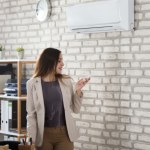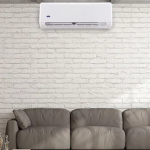Can an air conditioner be used for heating? How energy efficient is it?
Can an air conditioner be used for heating?
Yes, many air conditioners can be used for heating as well as cooling, with the inclusion of a reversing valve.
The energy flow can be reversed which transforms the air conditioner into a heater. This is called reverse-cycle technology. It is an electrical climate-control system that provides refrigerated cooling as well as heating. If your air conditioning system is reverse-cycle it will have a heating mode function.
A split system is one of the most popular types of air conditioning available because it’s both convenient and efficient. A split-system air conditioner keeps the inside and outside units separated. The inside unit is quiet and sleek and holds just the long blower, cooling coil, and air filter. The outside unit houses the fan and compressor – this keeps the noise away from the living space.
Voltfix Electrical installs reverse-cycle split system air conditioners, click here for more information.
How energy efficient is an air conditioner for heating?
Many people are unaware that air conditioning units can also be used as heat pumps. The heat provided from a reverse-cycle system is often produced at a greater output than a traditional heat system and uses a lot less energy in the process.
You can reduce your carbon footprint and save money on your energy costs simply by using your air conditioner as a heater.
Reverse-cycle air conditioners are 300–600% efficient. This means that one unit of electrical energy can be converted into three to six times more cooling or heating energy. Some reverse-cycle air conditioners have achieved efficiencies over 1000% under mild operating conditions.
Keep your air-conditioner temperature set at roughly 8 degrees Celsius below the outside temperature in Summer (or 8 degrees above the outside temperature in Winter), every degree lower/higher will increase yours running costs by approximately 10%. In Queensland, for best efficiency keep the air conditioner set at 24 degrees in Summer, or 20 degrees in Winter.
Using the heat mode, your air conditioner can warm your living spaces. The fan usually does not come on for the first 3-5 minutes when starting heat mode until the air conditioner warms up, otherwise it would be blowing cold air around the room.
What are the costs to use an air conditioner as a heater?
Average costs range from 13c–36c per hour when using a reverse cycle air conditioner to heat a room.
In comparison, an electric radiant heater will cost roughly 36c per hr, and an electric panel heater would cost 43c per hr. Neither of these work as effectively to heat large areas. Gas heaters will cost more coming in at 43c–51c per hr of use. While the most expensive option is the whole house fully ducted reverse-cycle air conditioner system that would cost $1.45–$2.12 per hr of use! (Source: Canstar Blue)
Reverse-cycle air conditioning versus Gas heaters
Reverse-cycle air conditioners and gas heaters are the two most popular heating options in Australia. But which is best?
The reverse-cycle air conditioner is capable of both cooling and heating your home. It can also be called a heat pump, as it extracts heat from outside air and then transfers the heated air inside. Gas heaters use radiant heating (otherwise known as gas combustion) that creates a flame to heat the air. The reverse-cycle system has greater energy efficiency.
- Affordable – no need to purchase an air conditioner and heater as the reverse-cycle air conditioner will do both jobs
- Safe – reverse-cycle air conditioners have no exposed elements, it is therefore a very safe way to generate heat. Reverse-cycle systems do not require routine servicing for safety like gas heaters.
- Efficient – gas heaters are more efficient in colder climates (such as Victoria) as not impacted by outside temperatures. In milder climates (like Queensland) this is not a concern.
- Durable – reverse-cycle systems have a lifespan of 20+ years.
- Speed – gas heaters can usually warm an area faster than reverse-cycle air conditioner.
- Energy efficient – reverse-cycle air conditioners are efficient in both cooling and heating, and are more efficient in both cost and energy consumption over time.
- Flexible and Adaptable – most reverse-cycle air conditioners have thermostats and advanced inverter technology to control the humidity and temperature of the room.
- Purification – some reverse-cycle air conditioners have air purifying filters built in and also enable the air to be dehumidified. The filter neutralise odours, traps airborne particles and deactivate viruses and bacteria. Perfect for households that suffer with hay fever and asthma.
- Eco-friendly – Environmentally friendly reverse-cycle air conditioners win hands down here as they produce only 1/3 of the amount of greenhouse gas emissions of gas heaters.
Living in Queensland, reverse-cycle air conditioners are the best way to go for heating and cooling. They offer affordability, safety, efficiency, durability, energy efficiency, flexibility, purification and are eco-friendly.
Contact the friendly team at Voltfix Electrical today to find out which reverse-cycle air conditioning systems would suit your home or office.





